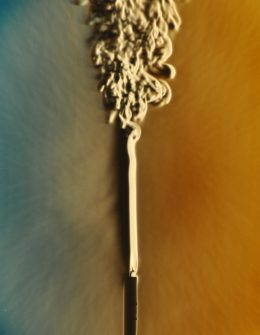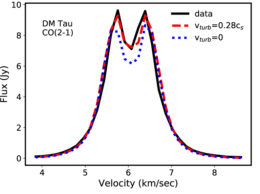Planets begin their lives shrouded in mystery, embedded in the swirling disks of gas and dust that surround newly born stars. As we try to understand the physical processes at play in these obscured environments, one stands out as a particular unknown: turbulence. New observations have now given us a look at the presence — and absence — of turbulence in planet-forming disks.
A (Theoretical?) Disruption

This image captures the transition between laminar and turbulent flow in the convection plume above a candle flame. [Gary Settles]
But are real planet-forming disks actually turbulent? This question is surprisingly difficult to answer, and we’ve managed only a handful of indirect measurements of turbulence in protoplanetary disks so far. A new study led by Kevin Flaherty (Williams College) uses the high resolution of the Atacama Large Millimeter/Submillimeter Array (ALMA) to add a few more data points to the collection, exploring gas motions in the outer regions of three different protoplanetary disks.

ALMA spectrum of the DM Tau CO (2–1) emission (black line). The model that includes turbulence (red) is a significantly better fit to the data than the model with no turbulence (blue). [Adapted from Flaherty et al. 2020]
Smooth Sailing or Rough Seas
By using models to interpret the ALMA observations of carbon monoxide emission from the disks, Flaherty and collaborators were able to place constraints on the amount of turbulence in each of these three planet-forming environments.
The authors show that the disks MWC 480 and V4046 Sgr both have only weak — if any — turbulence. The disk DM Tau, on the other hand, is a different story: it shows gas speeds indicative of significant turbulent motion.
This dichotomy of results is convenient: it gives us an excellent opportunity to explore the similarities and differences between these disks to try to understand what factors lead to a turbulent planet-forming environment instead of a calm one.
Exploring Potential Factors
One factor proposed to influence turbulence is the strength of ionizing radiation that reaches the outer disk. DM Tau is the only one of the three systems that doesn’t show evidence of a radiation-blocking inner disk wind, which could mean that more ionizing radiation reaches the disk’s outer edges in DM Tau, driving the turbulence we’ve observed.Another option is that DM Tau might have stronger magnetic fields than the other systems. It’s also possible that the system’s age — at just a few million years old, DM Tau one of the youngest targets in the sample — could be a factor affecting turbulence strength.
Overall, Flaherty and collaborators suggest that weak turbulence may be a common feature in planet-forming disks — but it’s clear that some outliers like DM Tau exist. More observations like the ones presented here will help us to further understand these mysterious, shrouded planetary nurseries.
Citation
“Measuring Turbulent Motion in Planet-forming Disks with ALMA: A Detection around DM Tau and Nondetections around MWC 480 and V4046 Sgr,” Kevin Flaherty et al 2020 ApJ 895 109. doi:10.3847/1538-4357/ab8cc5


2 Comments
Pingback: Burzliwe początki przyszłych planet? – PTMA Kraków
Pingback: Burzliwe początki przyszłych planet? – Astronomia Śląska